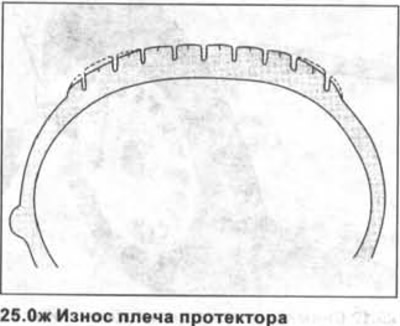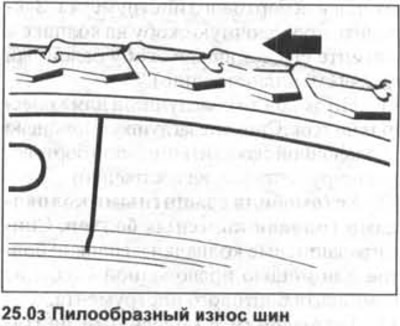Tire cleaning
Do not wash tires with a steam jet. If the nozzle of this device is held too close to the tire, then its rubber layer is irreversibly destroyed within a few seconds, which cannot be repaired even by applying cold water.
Tires cleaned in this way must be replaced for safety reasons.
Tires that have been in contact with oil or grease for a long time must also be replaced.
In this case, the tire first swells, and then returns to its normal shape and looks intact on the outside, but the tire's load-bearing capacity is reduced.
Tire storage
Tires should be stored in a cool, dark and dry place. They must not come into contact with lubricants, oils or fuels.
Store wheels lying flat or suspended from rims in a garage or basement. If tires are not mounted on rims, they must be stored in a standing position.
Increase tire pressure slightly before removing wheels (by about 0.3-0.5 bar). For winter tires, use your own rims, since remounting tires for summer rims does not justify itself in terms of economy.
Tire break-in
The new tires have a particularly smooth surface. This is due to the manufacturing process. For this reason, new tires, including a new spare wheel, must be run in.
During the running-in process, as a result of the onset of abrasion, the smooth surface becomes rough.
Before driving the first 300 km with new tires, the driver must be especially careful when driving on wet roads.
Changing/Changing Wheels
Attention! Change tires not separately, but at least the tires of both wheels of one axle. In this case, tires with a larger residual tread depth must always be installed in front, on the front wheels. All 4 wheels should only be fitted with tires of the same type and, if possible, with the same type of tread pattern and from the same manufacturer. Tires that are more than 6 years old should only be installed if absolutely necessary and be extremely careful when driving, never use used tires whose origin is unknown. When replacing wheels and tires, be sure to change the valve as well.
With noticeably greater wear on the front wheels, it is recommended to swap them with the rear ones. This ensures approximately equal service life of all 4 wheels.
It is not advisable to change the direction of rotation of the tires when rearranging the wheels, because. Tires are only run in to the new direction of rotation after heavy wear. On some tire models, the direction of travel is indicated by an arrow on the sidewall of the tire. In these cases, the indicated direction of movement must be strictly observed.
Tires with the prescribed direction of rotation, which can be identified by the arrow on the sidewall indicating the direction of travel, must always be installed in the direction of travel (see illustration).


This ensures optimum tire performance in terms of aquaplaning, road grip, driving noise and wear.
If it is necessary to install a spare wheel with the prescribed direction of rotation instead of «let down», but the prescribed direction will not be preserved, then such a replacement should be temporary.
In this case, it is recommended, especially on a wet track, to observe the speed limit.
Incorrect tire wear
First of all, you need to maintain the prescribed pressure in the tires. Moreover, the pressure check should be carried out at least once every four weeks and without fail - before each long trip.
Check pressure only when tires are cold. When driving fast, it rises due to the heating of the tires. However, of course, you should not bleed air from heated tires.
For front wheels, slightly more wear on the shoulder of the tread than wear on the middle of the tread is normal. Moreover, due to the slope of the road, the wear of the tread shoulder facing the middle of the road (for the left wheel - the outer shoulder, for the right - the inner), may be more pronounced (see illustration 25.0g).

Uneven tire wear is mostly the result of too low or too high tire pressure. Uneven wear can be caused by incorrect adjustment of the wheel alignment angles, poor balance, as well as defects in both shock absorbers and discs.
If the pressure is too high, the middle of the tread wears out more, as the tread bends under the influence of high internal pressure.
If the pressure is too low, there is a greater load on the tread shoulder, and the middle of the tread flexes inward, hence more wear on the tread shoulder.
Sawtooth tread wear is usually due to vehicle overload.


Visitor comments